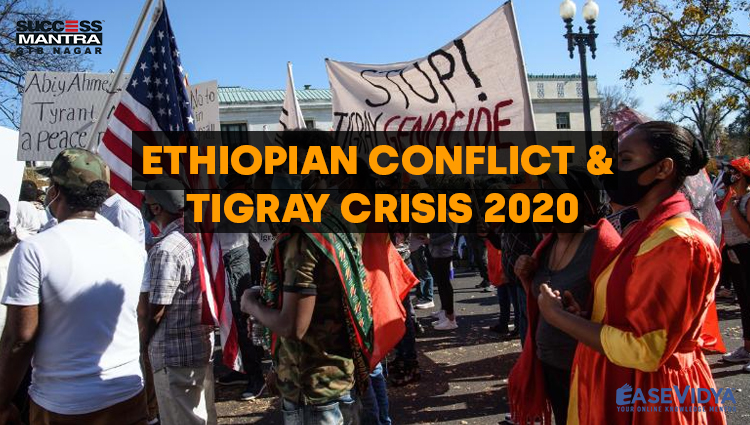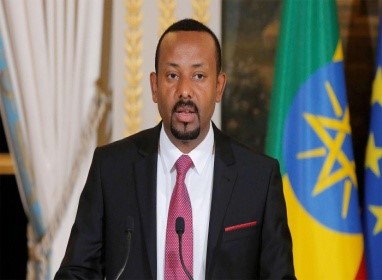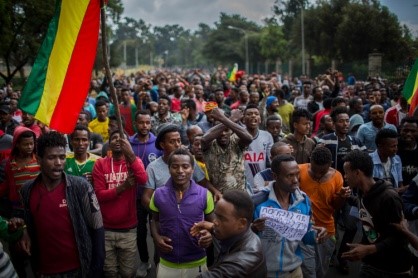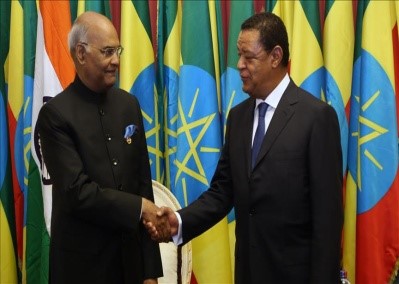
ETHIOPIAN CONFLICT AND TIGRAY CRISIS 2020
ETHIOPIAN CONFLICT & TIGRAY CRISIS 2020

The Ethiopian Prime Minister Abiy Ahmed has vowed to continue the military operation in the Tigray region amid concerns it could descend into civil conflict. Nearly 30 years after the end of its 17-year civil war, Ethiopia is on the brink of another disastrous conflict. The heightening military encounter between the Government of Ethiopia and the State Government of Tigray region may destabilize 110 million population of the country. Ethiopian Prime Minister has ordered Tigray forces to 'surrender peacefully' within 72 hours as the Government troops advance on the capital, Mekelle. However, TPLF has vowed to keep fighting against the Federal Government. Abiy has declared war on the country’s Tigray region, which is ruled by the powerful Tigray People’s Liberation Front (TPLF), in response to its attack on a federal military base in Tigray.
BACKGROUND OF THE ETHIOPIAN CONFLICT
After becoming Ethiopia’s Prime Minister in April 2018, Abiy Ahmed reached out to the political opposition, ushered democratic reforms, lifted curbs on the media and made peace with Eritrea - moves that won him the Nobel Peace Prize in 2019. Eritrea is a sworn enemy of the TPLF, which shares a long border with the Tigray region.
He also removed TPLF from senior government positions. His push to concentrate more power in the hands of the government alienated the TPLF further. Abiy has formed a new political coalition, the Prosperity Party, all constituents of the Ethiopian People’s Revolutionary Democratic Front (EPRDF), except the TPLF, joined the new platform. When the federal government postponed the general elections in August to 2021 citing the coronavirus pandemic, Tigray politicians accused him of a power grab and held elections, in September, in the region, in defiance of the government. Rising tensions led to an attack on the military base.
TIGRAY PEOPLE'S LIBERATION FRONT

• It is a militia-turned-party, which was part of the coalition that brought an end to the military dictatorship in 1991. TPLF leader Meles Zenawi took over as the interim President in 1991 and became the first elected Prime Minister in 1995. He is largely seen as the architect of the country’s ethno-federal system and remained in power till 2012. It had played a dominant role in the country’s ruling coalition, the Ethiopian People’s Revolutionary Democratic Front (EPRDF - put together by Zenawi).
• Though the EPRDF contains regional political parties such as the Amhara Democratic Party, the Oromo Democratic Party and the Southern Ethiopian People’s Democratic Movement, the TPLF remained the dominant political force. The Tigray people make up roughly 6% of the population, while the Oromos have a 34% share and the Amharas 27%. The Oromos have alleged marginalisation and called for better representation. Over the years, the government led by the EPRDF, was accused of being increasingly authoritarian and there were frequent mass protests in the regions. In 2018, the EPRDF chose Abiy, a former military intelligence officer, to lead the government amid growing protests and a political deadlock.
• Abiy’s Stand: Abiy, the country’s first Oromo leader, claimed that his actions are not driven by ethnic calculations but rather aimed at addressing the historic power imbalance in the country and making peace with the neighbours.
MAJOR IMPACTS OF THE CONFLICT
TPLF has fired rockets into Eritrea from Tigray, threatening a wider regional war in the Horn of Africa. Horn of Africa houses the countries of Djibouti, Eritrea, Ethiopia and Somalia. Rebels also fired rockets into the neighbouring Amhara region. Even if Abiy is serious about keeping the operation short, it could spill out of control given the underlying complexities of the conflict. The TPLF has thousands of fighters under their command. Also, the Tigray region shares a border with Sudan. The TPLF enjoyed good relations with Sudan’s ousted dictator Omar Bashir. Sudan has an unresolved border dispute with Ethiopia. If Sudan’s new rulers keep the old links with the TPLF active and the border open for the rebels, the conflict could go on. Earlier this year, in the midst of Ethiopia’s long-standing conflict with Egypt over the construction of the Grand Ethiopian Renaissance Dam over the Blue Nile, Sudan had already found itself forcefully involved in the spat. There have also been reports of atrocities targeting civilians by both sides. Many have even fled to Sudan.
The United Nations High Commissioner for Refugees (UNHCR) reported that thousands of refugees had been crossing the border and arriving in Sudan after the military conflict and anticipated many more to arrive as the conflict escalates. There have been humanitarian concerns in Ethiopia as phone and internet connections have been down since the beginning of the conflict. The Ethiopia-Eritrea war already displaced thousands of civilians and the latest conflict adds on in the number of displaced people and may lead to a humanitarian crisis in the country. The Ethiopian government is ready to receive and reintegrate our fellow Ethiopians fleeing to neighboring countries. We vow to our innocent civilians that have fled, to protect their property, enable humanitarian support by the ENDF and guarantee their peace upon return.
Amid the military conflict in Ethiopia, people are moving to Sudan in large numbers and the country may witness a civil war. Many experts are of the view that if this internal conflict spills outside Ethiopian borders, it has the potential to destabilise the Horn of Africa region. The Horn of Africa has 4 countries, namely, Somalia, Ethiopia, Eritrea and Djibouti. Also, the United States and China have their strategic military bases in the region, the closest being Djibouti. Any impact on these military bases and facilities may result in the involvement of the respective countries in the internal military conflict of Ethiopia.
INDIA-ETHIOPIAN RELATIONSHIP

• Ethiopia is one of the largest recipients of long term concessional credit from India in Africa.
• Lines of Credit worth more than USD1 billion have been sanctioned to Ethiopia for sectors such as rural electrification, sugar industry and railways.
• Tele-Education and Tele-Medicine services under the Pan African e-network Project was launched in Addis Ababa in July 2007.
• The Tele-Education project has been replicated by the Ethiopian side and linkages established between the Addis Ababa University and the Indian Institutes of Technology at Delhi and Kanpur.
• Bilateral trade between Ethiopia and India stood at USD 1.28 billion in 2018-19, out of which Indian exports to Ethiopia were USD 1.23 billion and imports were USD 55.01 million.
• There are more than 586 Indian companies in Ethiopia employing more than 55,000 people with licensed investment of over USD 4 billion. About 58.7% of Indian investments are in the manufacturing sector, followed by agriculture (15.6%).
CONCLUSION
Abiy can reach out to regional political leaderships, especially the TPLF, find common ground, and run the country peacefully by restoring the balance between ethnicities and regions and decentralising the federal government. The protection of civilian safety and security is essential. The African Union can play a role in this. Nobel laureate Abiy Ahmed Ali is the youngest Head of Government in Africa. On 2 April 2018, he became the youngest Prime Minister of Ethiopia at the age of 41. Born of a Muslim father and Ethiopian Orthodox Tewahedo Church Christian mother, he is seen as an inspirational leader who would usher changes in Ethiopia.
QUESTIONS (1-5)
Q.1 Which is of following is the Prime Minister of Ethiopia who is also awarded with Nobel Peace Prize for maintaining peace in the nation?
A. Abiy Ahmed: ANSWER
B. Jawar Mohammed
C. Meles Zenawi
D. Mikael Imru
Q.2 Which of the following statement is/are incorrect in the context of the Ethiopian Tigray Crisis or the Ethiopian conflict?
A. There is encounter between the Government of Ethiopia and the State Government of Tigray region.
B. Eritrea, which is an African country is in conflict with Tigray.
C. Abiy Ahmed is the leader of Tigray People's liberation front: ANSWER
D. None of the above
Q.3 Which of the following leaders of TPLF became the first elected Prime Minister in 1995?
A. Abiy Ahmed
B. Jawar Mohammed
C. Meles Zenawi: ANSWER
D. Mikael Imru
Q.4 Which of the following countries is not a part of Horn of Africa?
A. Djibouti
B. Eritrea
C. Ethiopia
D. Egypt: ANSWER
Q.5 The African Union which is a continental union consisting of 55 member states is headquartered at which of the following places?
A. Mogadishu, Somalia
B. Addis Ababa, Ethiopia: ANSWER
C. Djibouti City, Djibouti
D. None of the above












0 Comment